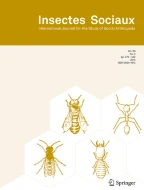204Accesses
28Citations
3Altmetric
Summary
Females of three European species of cuckoo bumble bees (P. bohemicus, P. vestalis, andP. campestris) were introduced into free-foraging laboratory colonies of theirBombus hosts (B. locorum, B. Terrestris andB. pascuorum, respectively). The colony development of one successfully parasitized colony of each bumble bee species was studied.Psithyrus females cohabited with host queens and workers, but monopolized brood development through oophagy, larval ejection and the attempted dominance of host bees. SomePsithyrus brood also was destroyed, and host bees in all three colonies were successful in rearing reproductive offspring. Prolonged social contact betweenPsithyrus females and their hosts, and the possibility of host reproduction in parasitized colonies, suggest that there is considerable opportunity for coevolutionary complexity inBombus-Psithyrus relationships.
Resume
Nous avons introduit des femelles de trois espèces européennes (P. bohemicus, P. vestalis etP. compestris) dans des colonies de laboratoire de leur hôteBombus (B. lucorum, B. terrestris etB. pascuorum) pouvant fourrager librement. Pour chaque espèce de bourdon, nous avons étudié le développement d'une colonie, où des parasites avaient été introduits avec succès. Les femellesPsithyrus ont cohabité avec les reines et les ouvrières hôtes, mais ont monopolisé le développement du couvain à travers l'oophagie, l'expulsion des larves, et les tentatives de dominer les bourdons hôtes. Une partie du couvainPsithyrus a été détruite aussi, et les bourdons hôtes des trois colonies ont réussi à élever du couvain de reproducteurs. Les contacts sociaux prolongés entre les femallesPsithyrus et leurs hôtes, ainsi que la possibilité de reproduction de l'hôte au sein des colonies parasitées semblent indiquer que des complexités coévolutives dans les rapportsBombus-Psithyrus ne sont pas rares.
This is a preview of subscription content,log in via an institution to check access.
Access this article
Subscribe and save
- Get 10 units per month
- Download Article/Chapter or eBook
- 1 Unit = 1 Article or 1 Chapter
- Cancel anytime
Buy Now
Price includes VAT (Japan)
Instant access to the full article PDF.
Similar content being viewed by others
References
Alford D.V., 1975.—Bumblebees,Davis-Poynter, publ., London, 352 pp.
Cumber R.A., 1949.—Humble-bee parasites and commensals found within a thirty mile radius of London.Proc. R. ent. Soc. Lond., A 24, 119–127.
Fisher R.M., 1984.—Dominance by a bumble bee social parasite (Psithyrus citrinus) over markers of its host (Bombus impatiens).Anim. Behav., 32, 303–304.
Fisher R.M., 1987 a.—Queen-worker conflict and social parasitism in bumble bees.Anim. Behav., 35, 1026–1036.
Fisher R.M., 1987 b.—Temporal dynamics of facultative social parasitism in bumble bees.Anim. Behav., 35, 1628–1636.
Fisher R.M., Weary D.M., 1988.—Buzzing bees: communication between bumble bee social parasites (Hymenoptera: Apidae) and their hosts.Bioacoustics, 1, 3–12.
Free J.B., Weinberg I., Whiten A., 1969.—The egg-eating behaviour ofBombus lapidarius L.Behaviour, 35, 313–317.
Hoffer E., 1888.—Die schmarotzerhummeln Steiermarks. Lebensgeschichte und beschreibung derselben.Mitt. naturw. Ver. Steirermark, 25, 82–158.
Honk C.G.J. van, Velthuis H.H.W., Röseler P.F., Malotaux M.E., 1980.—The mandibular glands ofBombus terrestris queens as a source of queen pheromones.Ent. Exp. & Appl., 28, 191–198.
Honk C. van, Röseler P.F., Velthuis H. Malotaux M., 1981.—The conquest of aBombus terrestris colony by aPsithyrus vestalis female.Apidologie, 12, 57–67.
Michener C.D., 1974.—The Social Behavior of the Bees.Harvard Univ. Press, publ., Cambridge, 404 pp.
Salkeld E.H., 1978.—The chorionic structure of the eggs of some species of bumblebees (Hymenoptera: Apidae: Bombinae), and its use in taxonomy.Can. Entomol., 110, 71–83.
Sladen F.W.L., 1912.—The humble-bee, its life history and how to domesticate it.Macmillan and Co., publ., London, 283 pp.
Tod C., 1986.—Socio-economic effects on colony size in the bumble beeBombus terrestris (Hymenoptera: Apidae).MSc Thesis, Massey University, New Zealand, 85 pp.
Trivers R.L., Hare H., 1976.—Haplodiploidy and the evolution of the social insects.Science, 191, 249–263.
Webb, 1961.—The biology of the bumble bees of a limited area in eastern Nebraska.Ph.D. thesis, Univ. Nebraska, Lincoln, 337 pp.
Wilson E.O., 1971.—The Insect Societies.Harvard Univ. Press, publ., Cambridge, Mass, 548 pp.
Author information
R. M. Fisher
Present address: Department of Botany and Zoology, Massey University, Palmerston North, New Zealand
Authors and Affiliations
Department of Zoology, S. Parks Road, OX1 3 PS, Oxford, UK
R. M. Fisher
- R. M. Fisher
You can also search for this author inPubMed Google Scholar
Rights and permissions
About this article
Cite this article
Fisher, R.M. Observations on the behaviours of three European cuckoo bumble bee species (Psithyrus).Ins. Soc35, 341–354 (1988). https://doi.org/10.1007/BF02225810
Received:
Accepted:
Issue Date:
Share this article
Anyone you share the following link with will be able to read this content:
Sorry, a shareable link is not currently available for this article.
Provided by the Springer Nature SharedIt content-sharing initiative



